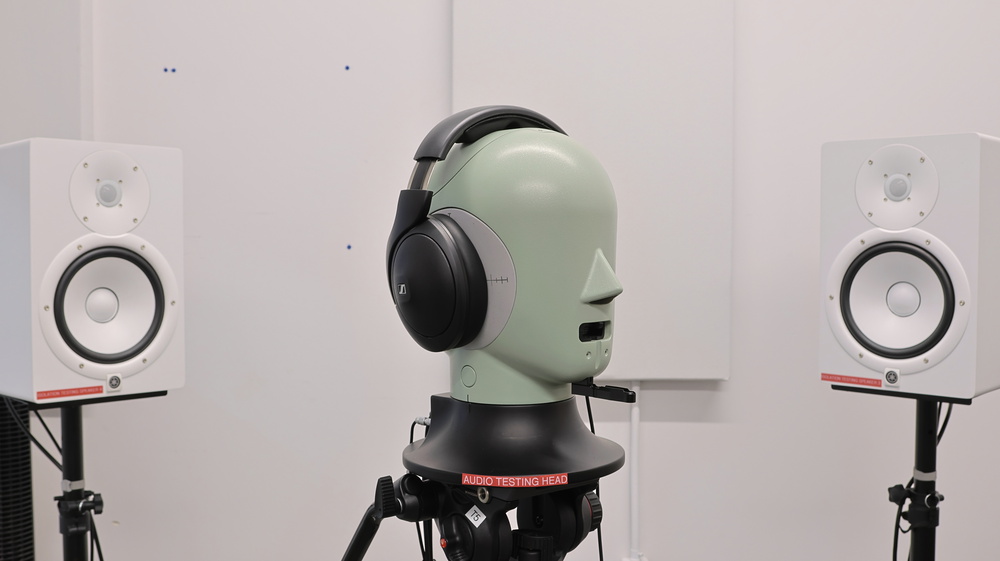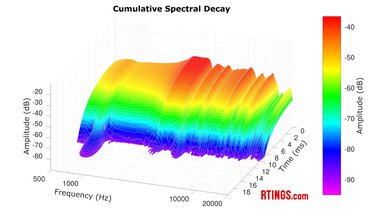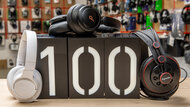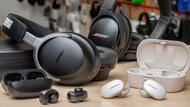The Sennheiser HD 620S are higher-tier closed-back headphones that the manufacturer promises can supply a wide and immersive soundstage like open-back headphones without all the limitations of open-backs, like a lack of isolation and deep bass. Kitted out with creature comforts like thick padding and a cable that connects to one side, these appear to be aimed at enthusiasts rather than audio professionals. Their feature set and visual design share similarities with the enthusiast-oriented Sennheiser HD 560S. However, they're in the same line as the Sennheiser HD 600, which are venerable mixing headphones used by the pros. If nothing else, the HD 620S are already posed to break conventions and appeal to a niche audience, so let's see if they manage to synthesize the best parts of open-back and closed-back headphones.
Our Verdict
The Sennheiser HD 620S are passable for sports and fitness. While not the best pair of headphones to take to the gym, due to their bulky design, absence of an IP rating, and wired-only connection that can snag on equipment, they're still comfortable and well-made.
-
Very comfortable.
-
Well-built headphones.
-
Not very portable.
-
No water, sweat, or dust resistance.
The Sennheiser HD 620S are acceptable for travel use. They're wired-only headphones, so you don't need to worry about battery life, but you're limited in what you can plug into. Their plush cushioning is very comfortable for long periods, and they don't leak much noise into the space. They also playback your audio sounding fairly balanced, although that depends on your anatomy, because their frequency response consistency varies significantly between people. However, they also struggle to block out much environmental noise, so airplane ambient din and talkative passengers reach your ears unabated, though some high frequencies are tamed a bit.
-
Very comfortable.
-
Well-built headphones.
-
Not very portable.
-
Passive isolation can't block out low-frequency noises.
The Sennheiser HD 620S are poor for office work. While they're well-built and very comfortable to wear, they also don't isolate noises in the background like chatty colleagues. They don't have a microphone either, which means you'll need to rely on an outboard mic for work calls and meetings. Still, for wired headphones with passive noise isolation, they reproduce your audio with a largely balanced tuning and don't leak much of what you're listening to into the office.
-
Very comfortable.
-
Well-built headphones.
-
Sub-par frequency response consistency.
-
No microphone.
-
Passive isolation can't block out low-frequency noises.
The Sennheiser HD 620S are wired-only headphones, so they won't work wirelessly.
The Sennheiser HD 620S aren't bad for wired gaming. Their drivers are well-matched, so you can reliably locate objects in the stereo mix. They're well-built and comfortable to wear with cushioned ear pads. They also comply well with our target curve for a balanced sound signature overall. On the other hand, their frequency response consistency can vary and change how they sound on different people. They also don't interact with your outer ear's pinna much, so your sense of immersiveness doesn't mimic an angled reference speaker. They also don't have a microphone, so if you play on a team and don't have an outboard mic, you'll need one.
-
Very comfortable.
-
Well-built headphones.
-
Sub-par frequency response consistency.
-
No microphone.
The Sennheiser HD 620S have very good audio reproduction accuracy. Their frequency response complies well with our target across the bass, mids, and treble for an overall balanced sound signature. They exhibit low harmonic distortion, resulting in a clean signal, and the L/R are well-matched for a stable stereo sound. On the other hand, they have disappointing frequency response consistency, leading to notable differences in how they sound on different wearers, and their peaks and dips are decent, but some frequencies can jump out from the mix a bit or get buried. They also don't interact with your outer ear the way that an angled reference speaker would, which weakens their immersiveness.
The Sennheiser HD 620S have middling noise isolation. They're closed-backs but they only passively isolate, so high-pitched background noise is somewhat muffled, though chit-chat and deep rumbles aren't strongly attenuated. As a result, you'll still hear some of the sounds in your circumstances.
The Sennheiser HD 620S don't include a microphone.
The Sennheiser HD 620S have disappointing frequency response consistency. As a result, they sound rather different on different people, particularly in the bass range. If you wear glasses, the frames break the seal and weaken the bass. Meanwhile, if you have a larger head, they sound bassier, more so than our raw frequency response measurement.
- 6.2 Sports And Fitness
- 6.4 Travel
- 4.7 Office Work
- 4.3 Wireless Gaming (In Development)
- 6.3 Wired Gaming (In Development)
Performance Usages
- 7.8 Audio Reproduction Accuracy
- 5.5 Noise Isolation
- 0 Microphone (In Development)
- 5.2 Frequency Response Consistency
Changelog
-
Updated May 21, 2025:
This review has been updated to Test Bench 2.0, which adds the following tests: Stereo Mismatch, Group Delay, Cumulative Spectral Decay, PRTF, Harmonic Distortion, and Electrical Aspects. We've added new performance usages and updated the text throughout the Sound tests.
- Updated May 14, 2025: We've converted this review to Test Bench 2.0, which updates our sound tests and adds performance usages. You can read more about this in our changelog.
-
Updated Nov 20, 2024:
The following test groups have been updated after Test Bench 1.8: Sound Profile, Raw Frequency Response, Bass Profile: Target Compliance, Mid-Range Profile: Target Compliance, Treble Profile: Target Compliance, and Peaks/Dips. Text changes have also been made throughout the review to match these results.
- Updated Nov 19, 2024: We've converted this review to Test Bench 1.8, which updates our target curve and Sound tests. You can read more about this in our changelog.
- Updated Jul 23, 2024: Review published.
Check Price
Differences Between Sizes And Variants
The Sennheiser HD 620S come in one color, 'Black.' You can see our unit's label here. If you come across other variants, let us know in the comments.
Popular Headphones Comparisons
If you ignore the marketing around the Sennheiser HD 620S, they're essentially closed-back headphones with angled transducers, and they look like the closed-back cousin to the open-backed Sennheiser HD 560S but with a chunkier build. Obviously, the HD 620S isolate better than their open-back counterparts, but their soundstage isn't as open by virtue of design limitations. Popular closed-backs like the Beyerdynamic DT 770 PRO score better PRTF results, and these also output more consistent bass than the Sennheiser HD 620S. Adding somewhat to the confusion is figuring out exactly who the HD 620S are for. The manufacturer states these are for audio enthusiasts, which can account for the focus on upgraded comfort and build, while more professional features like balanced cabling are available, but at an added cost.
Still trying to figure out what you want? Check out the best closed-back headphones, the best headphones for audiophiles, and, if you really want a spacious soundstage, the best open-back headphones.
The Sennheiser HD 620S and FIIO FT1 are both very comfortable closed-back headphones. Which you'll like best relies on whether you want a more laid-back, balanced tuning, as with the Sennheiser, or a warmer, bassier sound profile, as with the FIIO. The Sennheiser are better built with tighter L/R driver matching. However, you get fewer accessories, like a single average 3.5mm cable and basic pouch, which cheapens the package somewhat. The FIIO, on the other hand, are more visually arresting, with wood on the ear cup housings, and they also come with a proper zip case and a second balanced audio cable. While neither pair has great frequency response consistency, the FIIO are slightly better in this regard, but it's worth checking the graphs to see how people with your anatomy or accessories (head size, hair length, glasses, etc) fare when wearing them.
While both headphones are well-made and comfortable, choosing between the Beyerdynamic DT 770 PRO and the Sennheiser HD 620S depends on your tuning preference. The Beyerdynamic have a more consistent frequency response, translating to a more predictable sound profile regardless of your head shape or if you wear glasses. Although neither pair excels in this regard. Their sound is much brighter than the Sennheiser, which can inch you towards either pair depending on tastes, though both headphones isolate out noise similarly. On the other hand, the Sennheiser are more comfortable with fewer exposed wires, and you can replace the detachable cable.
The Beyerdynamic DT 700 PRO X deliver much more consistent sound between wears than the Sennheiser HD 620S. Their mostly metal build and extra cable feel more premium. The Sennheiser are slightly more comfortable to wear, but the bass delivery is negatively affected by wearing glasses. If you want a darker treble response, the Sennheiser don't boost treble as much as the Beyerdynamic.
Though they look similar, the biggest difference between the Sennheiser HD 560S and the Sennheiser HD 620S is that the former are open-back and the latter are closed-back headphones. As a result, the HD 560S supply a much more immersive sound. They're also lighter in weight, and they deliver a more consistent sound. Of course, they don't isolate noise like the HD 620S. The HD 620S are slightly more premium in build with a metal-reinforced headband, but they clamp tighter. Their fit is much more fussy and is more likely to deliver inconsistent sound. Overall, they provide a fuller, but less even, bass response, though that depends on your taste.
The Sennheiser HD 600 are open-back headphones with a much more open and spacious soundstage than the Sennheiser HD 620S. The HD 600 have a less erratic treble response and more detailed mids, though the bass is more subdued than the HD 620S. Your audio is also reproduced with better consistency on the HD 600. The closed-back HD 620S block out more environmental sounds due to their closed-back design. They're comfortable and well-made but don't deliver audio as consistently, and their sound isn't as immersive. Still, if you want more body in your bass, they provide a thicker-sounding thud.
The Sennheiser HD 490 PRO are open-back headphones with a more immersive sound than the closed-back Sennheiser HD 620S. The HD 490 PRO supply a much more consistent sound. They also include an extra set of ear pads and perform better than the HD 620S for people who wear glasses. The HD 620S are well-made and comfortable with a sparser set of accessories. Their noise isolation makes them more suitable to wear in different environments. Sadly, their bass response is highly impacted by their inconsistent frequency response, but if they fit you well, they add extra punch to the bass compared to the analytically tuned HD 490 PRO.
Video

We've upgraded our Headphones Test Bench to 2.0! This update brings several key changes to our tests and usages, making it easier than ever to interpret our sound results based on your personal preferences. You'll also find a brand-new interactive graph tool featuring multiple targets (including our own!) for you to explore and compare.
For a full breakdown, check out our changelog, which includes detailed commentary from our test designer explaining the rationale behind our update.
We'd also love to hear your thoughts: your feedback helps us keep improving, so join us in the comments!
Test Results
The Sennheiser HD 620S have a sound profile that boosts select bass frequencies more than the Sennheiser HD 600, their open-backed sibling, though not evenly. This broadly balanced sound signature produces a much more obvious punch and injects more thud to kick drums, but it's not perfectly even. The closest approximation of a target curve the headphones align with is the SoundGuys.com Studio Curve, albeit with a larger dip in the high-bass and low-mids, and a considerable peak in the low-treble compared to that target curve.
If you're interested in bringing these headphones' frequency response into line with one of the target curves shown on our Graph Tool, you can download a folder of EQ presets to do so.
These output a good amount of bass, but largely due to their inconsistent frequency response (which you can see in the next test), bass frequencies take a massive hit when the headphones are worn by different people, which is an important consideration.
The Sennheiser HD 620S have poor frequency response consistency. Their ability to deliver consistent bass is strongly impacted by their large ear cups, which often don't seal around your ear perfectly. Their soft ear pads, combined with the tight clamping force, can easily cause the seal to break because the padding doesn't always sit evenly, so you have to place them with care.
If you wear glasses, these can break the headphones' seal and dramatically reduce the bass. Unlike the Sennheiser HD 490 PRO, these don't include ear pads that have specialty ridges to accommodate glasses' arms without compromising the seal. On the other hand, if you have a large head, you'll hear much more bass in the mix than our measured frequency response.
Their bass profile's target compliance is excellent. They reproduce a laid-back amount of rumble through the low-bass and part of the mid-bass. A notable boost to the mid-bass and part of the high-bass adds a significant amount of punch and body to basslines in songs like The Night by Frankie Valli and the Four Seasons. However, the dip in the upper-bass frequencies clears up muddiness, which carries on into the mid-range.
Their mid-range target compliance is excellent. A slight de-emphasis in the low-mids can reduce the depth of lead instruments a bit. Otherwise, the headphones convey lead and melodic instruments evenly for the most part. The minor underemphasis can weaken vocals in the upper mids slightly, but otherwise, keys and guitars sound full.
Their treble's target compliance is remarkable. Most of the range approaches the target for a bright voicing that's largely representative of your audio. However, the range is somewhat uneven, reproducing vocals with a bit of harshness in the low-treble or weakened intelligibility, depending on the pitch. Sibilant sounds like S and T in vocals and cymbal hits are alternately dull and slightly piercing.
Their peaks and dips performance is decent. The headphones output a somewhat smooth sound. A small bump in the mid-bass injects a bit of body to the bass. A minor dip from the high-bass into the low-mid reduces boominess and clutter from thick rhythm guitars. Through the rest of the mids, a series of bumps and narrow dips mostly add focus to vocals and melodic instruments, but these are rather small.
The treble trends towards broadly clear and bright, but it's also hampered by narrow dips and peaks, which can render your favorite diva's vocals a bit harsh, clear, or dulled in the details, depending on the pitch. In the low-treble, a narrow peak adds harshness to vocals, and it's followed by an uneven couple of dips, which dull and hollow out the detail and articulation of voices and cymbal hits somewhat. The tall peak in the mid-treble adds sharpness and can make sibilant sounds like Ss and Ts sound a little painfully bright. Meanwhile, in the high-treble towards the threshold of human hearing, there are larger peaks and notches that can add brilliance or sound closed off.
These headphones have superb stereo mismatch overall. The L/R drivers are perfectly matched in weighted amplitude, so each side is as loud as the other. For the most part, the frequency response is decently matched, too; only in the highest frequencies is there a notable difference, but harmonics in the high-treble are also at the thresholds of audibility for most people, so it's not apparent with real-world content. The story is similar for the phase response mismatch. The largest deviations are in the high-treble, but they fall within good values below audibility, and there are narrow phase deviations in lower ranges, but they're very narrow, so you're unlikely to notice them affecting audio fidelity. That said, these results only apply to our pair of headphones, and yours may differ.
The Sennheiser HD 620S have satisfactory group delay performance. Most of the bass is reproduced tightly, but there are timing differences present in the mid- to high-bass, which can cause the low-end to sound somewhat loose. Otherwise, the treble sounds transparent.
The Sennheiser HD 620S have a disappointing PRTF performance. Outer-ear interaction can indicate your perception of distance and space, as with an angled reference speaker, and these don't mimic that.
The Sennheiser HD 620S exhibit superb harmonic distortion. At 94 dB/SPL and 104 dB/SPL, they retain the integrity of the audio without adding unwanted artifacts to the signal.
Depending on your audio source's output, you may or may not need a headphone amp to drive these to a good volume.
These are the settings used to test these headphones. Our results are only valid when used in this configuration.
The Sennheiser HD 620S are closed-back headphones that share aesthetic similarities to open-back headphones like the Sennheiser HD 560S and the Sennheiser HD 598. These have non-articulating oval ear cups and thick faux leather padding along the center of the headband and ear pads. The sliding headband glints with sections of silvery metal on an otherwise black plastic construction. Their straight cable is removable and terminates down the left side. Available in a single monochromatic black, the manufacturer's logo is placed on the outside of each ear cup, and the name is written along the top of the headband.
The Sennheiser HD 620S feel very comfortable. Their faux leather padding is generous around the ears where the headband meets your crown, and the headband distributes their weight well. Whether you have a larger or smaller head, the headband offers a good extension range. The clamping force is high, though, quite similar to other popular closed-backs, like the tight-fitting Beyerdynamic DT 770 PRO. While this compression should help these cans form a good seal on your head, the overall size of the ear cups makes it harder to get a reliable seal, particularly at the bottom of the ear cups. Wearing glasses can also make getting a good seal over your ears difficult, as the arms interrupt the seal, impacting their sound. On the upside, the ear cups are deep enough to accommodate most people's ears.
These headphones aren't very portable. They don't fold down any smaller, and the ear cups can't rotate to lay flat. You can remove their cable to make them easier to carry, but otherwise, they're pretty large, and you'll need real estate in your bag to tote them around.
The Sennheiser HD 620S are well-built. Their housings are mainly plastic with aluminum, reinforcing the headband, and they're amply padded. Their removable cable is good, too, covered in para-aramid, which feels sturdy. However, they're a bit stiff to adjust. Unlike the thicker covering over the drivers on the Sennheiser HD 598, there's not much of a buffer protecting the drivers from getting pierced or damaged, as you can see here.
The Sennheiser HD 620S have middling full-range noise isolation. As with most closed-back headphones that passively isolate you from external sounds, they have a much stronger impact on trebly sounds than lower frequencies; sudden and bright clinking sounds in your office kitchen are tamped down effectively. However, you'll still hear folks talking. Rumbling construction noise outside your window will reach you, too.
These headphones struggle to create an isolating seal with the glasses' arms. Because an unbroken over-ear seal is essential for optimizing isolation, you'll experience less effective noise isolation performance if you wear glasses.
You'll note the small bump in the bass region, and this appears to be unique to the headphones interacting with the testing rig and, importantly, not something you'll experience.
These have poor noise isolation in common scenarios. That's expected from headphones with passive-only isolation, which most effectively blocks high-pitched noises. For instance, if you're on an airplane, the lower mid-range and bassier ambient din can still reach your ears. In an office, your coworkers will get muffled somewhat, but not very effectively.
As mentioned in Noise Isolation - Full Range, the small bump in the bass region is not something you'll experience when you wear the headphones.
Their leakage performance is fair. What escapes is pretty even in volume across the mids and treble range, and sounds like vocals, lead instruments, snares, and cymbals are audible to those nearby in your household. Bass leaks, too, but not as noticeably. Because the headphones are closed-backs, they don't leak as much of your audio as open-backs, like the Sennheiser HD 560S.
The Sennheiser HD 620S are passive headphones with low latency. You can adequately drive them with most audio sources, like laptops, so they don't need a headphone amp. They include a para-aramid covered 6-foot cable that connects via its twist-and-locking 1/16" TRRS jack to the left ear cup, unlike the Sennheiser HD 490 PRO (aimed at audio professionals), which has separate wires going to each ear cup. The twist-and-lock design is secure, but it might be a pain if you need to find a replacement. You can also upgrade the package by opting for the manufacturer's balanced cable, which is available separately. The other end of the cable is a 1/8" headphone jack. You also get a 1/8" to 1/4" adapter.
Most PCs can sufficiently drive these headphones via their analog connection to your PC's headphone jack.
These headphones support audio only via their analog cable when connected to your PlayStation's controller.
You can plug the headphones into your Xbox controller's headphone jack for audio support only.
Comments
Sennheiser HD 620S: Main Discussion
Let us know why you want us to review the product here, or encourage others to vote for this product.
Update:
- 21010
If it helps, you could also use our comparison tool!
I have. It’s great. I just like your paragraphs. when you do an explicit comparison between two sets.
- 21010
Would like to see a comparison to the 650 and 599 in the “Compared To Other Headphones” section. Also be interesting to see a review of the 569 which is a closed-back set in the 500 series. I am trialing both currently, and think the 569 sounds almost as good as the 620s for $250 less.
If it helps, you could also use our comparison tool!





























































































